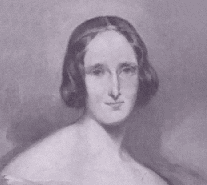 Mary Shelley, born in August 30 of 1797, was a prominent, though often
overlooked, literary figure during the Romantic Era of English Literature.
She was the only child of Mary Wollstonecraft, the famous feminist, and
William Godwin, a philosopher and novelist. The placenta would not expel
and a physician had to operate her mother. Unfortunately, an infection
arose and Mary Wollstonecraft died on September 10th. William
Godwin, who spent all but the last six months of his life alone, was left
with a young daughter. He was determined to raise her.
Mary Shelley, born in August 30 of 1797, was a prominent, though often
overlooked, literary figure during the Romantic Era of English Literature.
She was the only child of Mary Wollstonecraft, the famous feminist, and
William Godwin, a philosopher and novelist. The placenta would not expel
and a physician had to operate her mother. Unfortunately, an infection
arose and Mary Wollstonecraft died on September 10th. William
Godwin, who spent all but the last six months of his life alone, was left
with a young daughter. He was determined to raise her.
Mary Shelley was also the wife of the poet Percy Byshe Shelley. Mary's parents were shapers of the Romantic sensibility and the revolutionary ideas of the left wing. Mary, Shelley, Byron and Keats were principle figures in Romanticism's second generation. Whereas the poets died young in the 1820's, Mary lived through the Romantic era into the Victorian.
Mary was born during the eighth year of the French Revolution. "She entered the world like the heroine of a Gothic tale: conceived in a secret amour, her birth heralded by storms and portents, attended by tragic drama, and known to thousands through Godwin's memories. Percy Shelley would elevate the event o mythic status in his Dedication to The Revolt of Islam, (from page 21 of Romance and Reality by Emily Sunstein). From infancy, Mary was placed on her potential and she was treated as if she were born beneath a lucky star. Godwin was convinced that babies are born with a potential waiting to be developed. From an early age famous philosophers, writers, and poets surrounded her: Coleridge made his first visit when Mary was two years old. Charles Lamb was also a frequent visitor.
A peculiar sort of Gothicism was a part of Mary's earliest existence. Most every day she would go for a walk with her father to the St. Paneras churchyard where her mother was buried. Godwin taught Mary to read and spell her name by having her trace her mother's inscription on the stone.At the age of sixteen Mary ran away to live with the twenty-one year old Percy Shelley, the unhappily married radical heir to a wealthy baronetcy. To Mary, Shelley personified the genius and dedication to human betterment that she had admired her entire life. Although even her father cast her out of society, this inspirational liaison produced her masterpiece, Frankenstein.
She conceived of Frankenstein during one of the most famous house parties in literary history when staying at Lake Geneva in Switzerland with Byron and Shelley. Interestingly enough, she was only nineteen at the time. She wrote the novel while being overwhelmed by a series of calamities in her life. The worst of these were the suicides of her half-sister, Fanny Imlay, and Shelley's wife, Harriet.
After the suicides, Mary and Shelley reluctantly married. Fierce public hostility toward the couple drove them to Italy. Initially, they were happy in Italy, but their two young children died there. Mary never fully recovered from this trauma (their first child had died shortly after birth early in their relationship). Nevertheless, Shelley empowered Mary to live, as she most desire: to enjoy intellectual and artistic growth, love and freedom.
When Mary was only twenty-four Percy drowned, leaving her penniless with a two years old son.
For her remaining twenty-nine years she engaged in a struggle with the societal disapproval of her relationship with Shelley. Poverty forced her to live in England, which she despised because of the morality and social system. She was shunned by conventional circles and worked as a professional figures artists and politicians.
She eventually came to more traditional views of women's dependence and differences like her mother before her. This not a reflection of her courage and integrity but derived from socialisation and the conventions place don her by society.
Mary became
an invalid at the age of forty-eight. She died in 1851 of a brain tumour
with poetic timing. The Great Exhibition, which was a showcase of technological
progress, was opened. This was the same scientific technology that she
had warned against in her most famous book, Frankenstein.